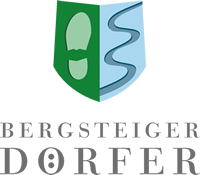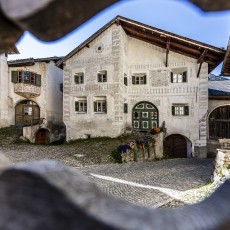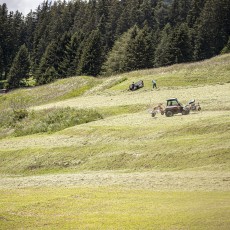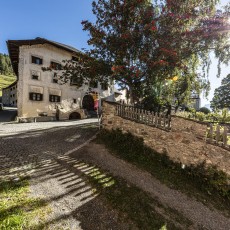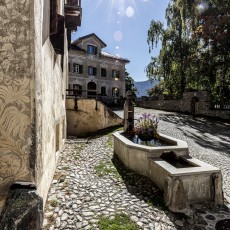Landwirtschaft
Organic farming is central to the three villages. Because there is little precipitation in the entire Lower Engadine, the meadows have to be irrigated. The farmers cultivate the land at the bottom of the valley intensively, but the steeper the slopes and the greater the distance to the village, the more extensive the farming. This is also reflected in the extraordinary floral splendour: arnica, man’s trefoil, fire lily, Turk’s cap or orchid and many more grow in the meadows above the villages. Cooperation in individual villages is very important. The farmers in Lavin, for example, do not only work as lone fighters, but also organise themselves collectively. They are united in a machinery cooperative that buys equipment such as manure barrels, conveyor belts or a claw stand and then makes them available to the farmers for a fee. The work on the alpine pastures, i.e. the care of the pastures, is also done jointly, as are the cattle drives to the alpine pastures and back again.
Nature and climate
The Lower Engadine is an inner-alpine dry valley. The average rainfall is 690 litres per year. Only the Valais, with around 600 litres, is even drier. The valley is influenced by different weather zones and has microclimates, which makes weather forecasting difficult. You never really know whether to look at the weather forecast for the south, for the Engadine or for the east.
Architecture
From an architectural point of view, Guarda and Ardez in particular are Engadine model villages.
All three villages are of national importance according to the Federal Inventory of Swiss Sites Worthy of Protection ISOS.
Tradition
Chalandamarz is the best-known Engadine custom. In the Rhaeto-Romanic language, “Chalandamarz” refers to the beginning of the month of March. On this day, the winter is rung out with bells and the approaching beginning of spring is celebrated. The custom is depicted in the well-known children’s book “Schellen-Ursli” by Selina Chönz and Alois Carigiet. Schoolchildren in peasant blouses, pointed caps and traditional costumes parade around the wells early in the morning with bells and whips, from house to house and sing Chalandamarz songs. They collect food and money for the communal meal and for the school trip.
Kunst
Sgraffito is a craft that adorns many Engadine houses and contributes to the unmistakable charm of the village scenes. This decoration technique came to Graubünden from Italy in the 16th century. In sgraffito, the ornaments are exposed from a damp layer of plaster covered with lime by scraping and scratching down to the dark layer underneath.
Nationalpark
Switzerland’s only national park is located in the Lower Engadine. Furthermore, the National Park was founded in 1914, making it the oldest national park in the Alps. You can find more information about the National Park here
